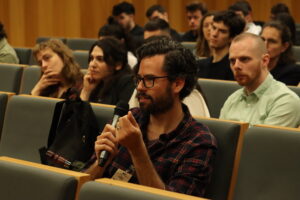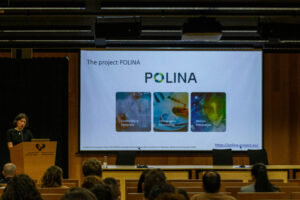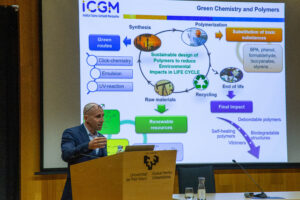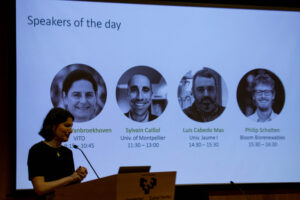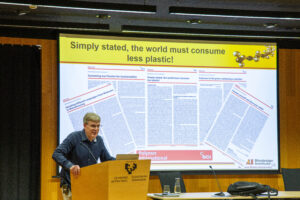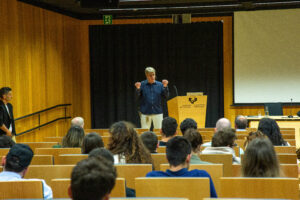🗓 May 22-23, 2024
📍 Carlos Santamaria Zentroa, San Sebastian (Spain)
📌 Registration is now closed!
The transition towards a circular polymer economy is increasingly encouraged by the global concerns on the emission of greenhouse gases and depletion or resources related with the polymer industry and the environmental impact of the mismanagement of plastic wastes.
Want to know the latest breakthroughs on the topic? Then join us on the 22 nd and 23 rd of May for a two-day seminar on the future of plastics, for transforming the polymer industry from a damaging linear production of plastics to a virtuous circular economy.
The event was imagined inside NATURE-EID and POLINA projects and organized by UPV/EHU-POLYMAT and Polykey with the support of the European Union.
DAY 1: Renewable resources for more circular plastics
Polymers synthesised from renewable sources stand as sustainable alternatives to petro-based polymers because they are produced from biomass derivatives or recycled raw materials. Immense challenges remain for these plastics to significantly contribute to a more circular plastic economy as they only represent 1% of the current plastics production worldwide.
The talented speakers of day 1 should help us understand what are these challenges and how they are about to be overcame with new processes, innovative catalysis methods and efficient technology transfer.
Karolien Vanbroekhoven. Biorefineries and industrial trends biobased building blocks: what’s on the move?
In the world of tomorrow, even if we would all consume less, a lot of carbon will always be needed to foresee in our primary needs as people like food but mainly for our daily product and material use. While moving away from fossil resources, the remaining options are recycling, CO2 and/or biobased. Different scenario’s exist, but for sure biomass is always part of the solution. Therefore, biorefineries play a crucial role in the transition towards a more sustainable and environmentally friendly industrial landscape. They are instrumental in the conversion of biomass into a wide range of valuable products, including biofuels, biochemicals, and materials. Over the past years, the development of new value chains in the biobased building blocks sector was very dynamic, driven by various trends and advancements. Technology develops, which allows innovations to move in technology readiness level, from lab to pilot, also delivering building blocks at kg to ton scale and thus promoting value chain development. This results in a very delicate play between suppliers and end-users. Economic elements always play a role (money is the language that everybody understands), and therefore should be taken into account when developing a chemical substitute/replacement early on, understanding the technology and its sensitivity elements like what cost is critical and should be improved. Finally, it all goes together with the regulatory framework, where subsidies can favor a certain development over a more sustainable one since both rely on a similar feedstock (biomass for energy versus materials), or new frameworks are developed that urge for a biobased, safer alternative. The different aspects will be explained using lignin refinery and its development as a use case.
Sylvain Caillol . A Journey around circularity in polymers, from renewable resources to recycling
Recent years have witnessed an increasing demand for environmentally friendly materials, particularly for polyurethanes (PU)s, which correspond to 6th polymer in the world with an annual production close to 20Mt. We have synthesized biobased polymers from renewable resources, particularly natural phenols, following a platform approach and convergent functionalization routes. Furthermore, in order to reduce the environmental impact, we have also proposed to replace some harmful monomers and additives by less harmful substances. Hence, we have proposed substitution of BPA in epoxy networks, and regarding PUs, we have developed a platform approach for the synthesis of non-isocyanates PUs. We have thoroughly investigated the reactivity, the interest and limits of this reaction leading to polyhydroxyurethanes (PHU)s, and particularly to hybrid PHUs. We have also designed self-healing polymers and coatings to improve the lifespan of polymers. In order to consider the full life cycle of materials, we also studied the recycling of thermosetting polymers especially by the synthesis of vitrimers.
Luis Cabedo Mas . Integration of Biodegradable Plastics into the Circular Economy: Challenges and Opportunities
One of the most pressing environmental challenges we currently face is undoubtedly the issue created by plastic waste. The massive consumption of plastic materials, combined with their often challenging post-consumer management and the persistence of their residues in the environment, renders mismanaged plastic waste a critical environmental threat. The solution to this problem lies in transforming the plastic industry into a circular paradigm, where plastic waste holds value as a raw material (thus allowing to be reintegrated into the industry through recycling), or can be treated as organic matter under suitable conditions. It is within this second approach that biodegradable materials emerge as a sustainable alternative to conventional plastics. However, being merely biodegradable is insufficient for a material to be genuinely beneficial to the industry or for its processing as organic matter to be feasible. This presentation will delve into the challenges that biodegradable polymers must overcome to serve as a true sustainable and circular alternative to plastic materials in the packaging sector. It will also explore the concept of biodegradation and its significance in the effective management of plastic waste.
Philip Scholten . Sustainable production of high-performance bio-based chemicals and materials
Biomass has been long deemed a ubiquitous resource for chemistry. However, the efficiency, cost, and performance of these processes and products have so far not matched the petroleum industry. Bloom is developing a biorefinery which enables to valorise all biopolymers present in biomass for the chemical industry with performance, cost, and sustainability outperforming petroleum derived analogues.
DAY 2: Circularity in Light-Mediated Additive Manufacturing
Additive Manufacturing (AM) has the potential for both reduced energy consumption and less polymeric material utilization. As the name implies, additive manufacturing contrasts with subtractive processes, as it relies on the layer-by-layer deposition of materials. This allows geometric designs of 3D objects with unprecedented complexity, in bulk and porous shapes with reduced waste generation. Among AM methods vat photopolymerization (VP) techniques are well established and considered one of the advanced AM techniques owing to the improved efficiency and printing resolution at the macroscale. However, little attention has been paid to the sustainability of the process in line with the industrial requirements.
Speakers from day 2 will help us to understand the key design parameter for next generation materials for AM, and how to increase the circularity of products derived from AM ensuring that this industrial revolution does not create a new plastic waste problem.
Timothy E. Long . Designing Advanced Macromolecules for Advanced Manufacturing: Balancing Reactivity, Rheology, and Resolution
Additive manufacturing (AM) offers the promise for addressing looming concerns for materials sustainability with chemical processes that require less energy and result in less material consumption. However, research must impose a lens of sustainability earlier in the innovation process, where processes and materials are designed to adhere to the principles of green chemistry and strive for more sustainable engineering. Novel materials for AM continue to emerge at a feverish rate, and it is imperative that we begin to consider end-of-life (EOL) earlier in the material and process design. Our research has focused on light-based AM modalities due to the unique combination of low energy consumption, exceptional resolution that enables less material consumption in latticed architectures, and the opportunity to print high molecular weight polymers with low viscosities. An important motivation is the opportunity to intensify chemical processes, wherein the synthetic chemistry occurs in a printed shape that serves as the reactor that ultimately results in a printed object. Advanced macromolecular materials for advanced manufacturing require a precisely tailored balance of reactivity and rheological performance that collectively ensure precise resolution from diverse additive manufacturing modalities. This lecture will exemplify our most recent efforts involving vat photopolymerization of fully aromatic polyimide hydrogels for printing carbonaceous objects, aqueous polymeric latexes for printing ABA triblock copolymer elastomers, and printing unsaturated polyesters in the absence of solvent with the opportunity for subsequent recycling. Polyimide polymeric salts offer desirable solution viscosity, and recent efforts have involved the tuning of crosslink density with mixed polysalts wherein the photo-active diacid concentration is precisely controlled. Sulfonation of diamines renders all-aromatic polyimide precursors in water, thus enabling the vat photopolymerization of polyimides in water. SIS triblock copolymers are prepared as a colloid and printed in the presence of an aqueous scaffold. Removal of water allows for the formation of nanostructured ABA triblock copolymers with tensile elongations exceeding 800%.
Joe DeSimone . The Delicate Interplay Between Light, Interfaces and Design: The Complex Dance that Allows 3D Printing to Scale to Manufacturing
The production of polymeric products relies largely on age-old molding techniques. In this talk, I will describe a breakthrough in additive manufacturing—3D printing—referred to as Continuous Liquid Interface Production (CLIP) technology (Science 2015). CLIP, and its recently introduced cousin injection CLIP (iCLIP; Science Advances 2022), embody a convergence of advances in software, hardware, and materials to bring the digital revolution to the design and manufacturing of polymeric products. CLIP uses software-controlled chemistry to produce commercial quality parts rapidly and at scale by capitalizing on the principle of oxygen-inhibited photopolymerization to generate a continual liquid interface of uncured resin between a forming part and a printer’s exposure window. Instead of printing layer-by-layer, this allows layerless parts to ‘grow’ from a pool of resin, formed by light. Compatible with a wide range of polymers, CLIP opens major opportunities for innovative products across diverse industries. Previously unmakeable products are already manufactured at scale with CLIP, including the large-scale production of running shoes by Adidas (Futurecraft 4D); mass-customized football helmets by Riddell; the world’s first FDA-approved 3D printed dentures; and numerous parts in automotive, consumer electronics, and medicine. At Stanford, we are pursuing new advances including new multi-material printing approaches, recyclable materials, materials for advanced ceramics, and the design of a high-resolution printer. High resolution 3D printing, combined with the ability to fabricate free-form negative spaces, open up new applications in microelectronics, “digital dust”—precision particles having un-moldable geometries (Nature 2024, in press), and drug/vaccine delivery devices including novel microneedle designs as a potent vaccine delivery platform and for the sampling of interstitial fluids for health monitoring and the early detection of disease.
Haritz Sardon . Sustainability Aspects in Additive Manufacturing: From biomass utilization to recyclability
Initially developed for rapid prototyping, additive manufacturing (AM) (colloquially 3D printing) is now scaling up its capacity to foster Industry 4.0 and operate a paradigm shift in the way products are manufactured. In addition to enabling new design capabilities, AM holds promises for increased social, economic, and environmental sustainability. Among AM methods vat photopolymerization (VP) techniques are desired owing to their improved efficiency and printing resolution. Nevertheless, the major portion of resins available for VP are based on systems coming from petroleum and/or with limited or negligible recyclability. In this lecture we will show how we can exploit the use of biomass as alternative interesting source for the production of 3D objects with enhanced properties and how we can implement new chemistries that differ from conventional light mediated non-recyclable free radical or cationic photopolymerization of (meth)acrylate or epoxide monomers to produce resins with circularity built into their performance.
Eva Blasco . Functional polymers for 4D microprinting: towards “living” systems
4D printing has become a promising tool for the fabrication of dynamic and adaptive structures. During the last years, promising examples of defined 4D microstructures employing stimuli-responsive materials have been shown using two-photon 3D laser printing. Herein, we present our recent work on the field with emphasis on new responsive materials enabling the preparation of adaptive and structures. In particular, shape memory polymers as well as liquid crystal elastomers have been explored. In the first case, a simple and versatile formulation has been developed enabling complex microstructures with remarkable shape memory properties. Also, multi-responsive structures using photo responsive liquid crystal elastomers, are demonstrated. Furthermore, we have exploited the inclusion of dynamic and living bonds in a printable formulation enabling the creation of microstructures with „life-like” characteristics such as adaptability by tunable shape and mechanical properties. In addition, we demonstrated at the macromolecular sequence, specifically the positioning of the crosslinkable group, plays a critical role in both the printability and final properties of the printed material. We envision that careful and precise design of new printable materials will open new opportunities for the additive manufacturing of functional devices in the near future.
Some photos of the event!


